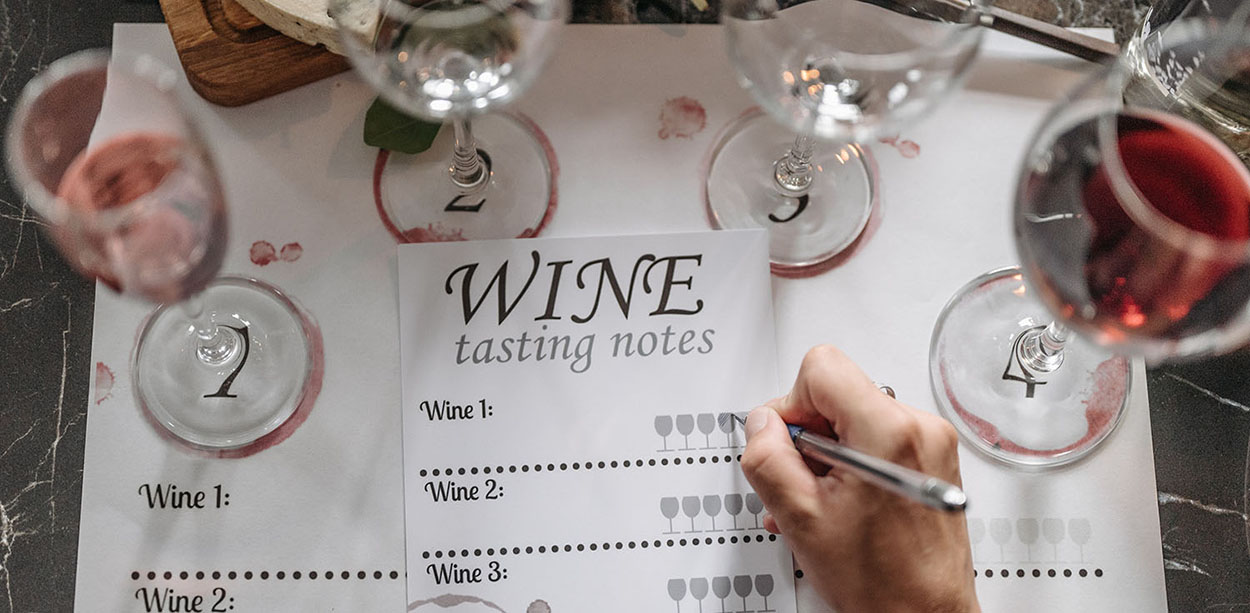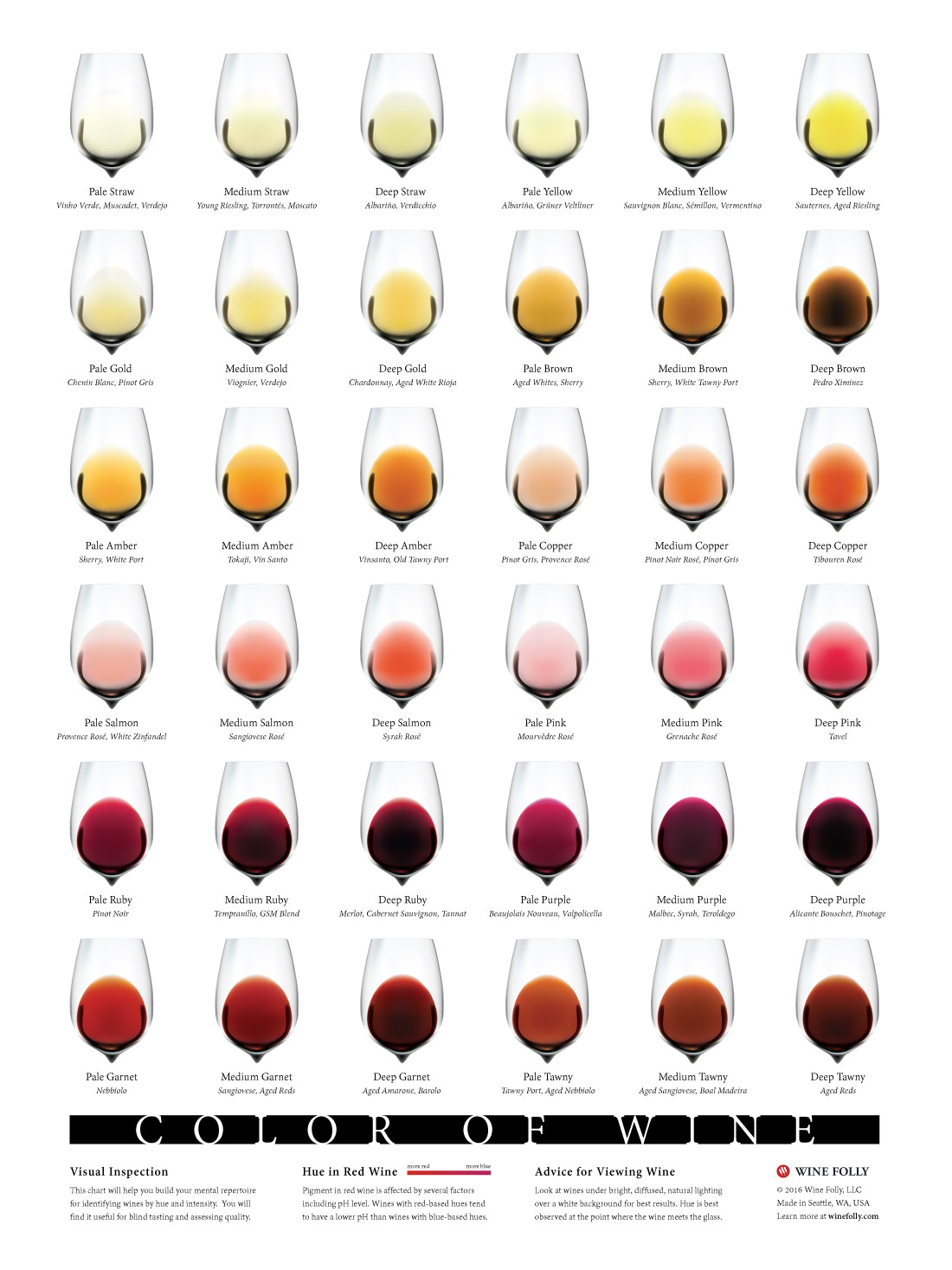
Blind-tasting wine is a delightful adventure accessible to anyone, not just reserved for sommeliers or upscale dining experiences. It’s a fantastic way to enhance your palate and uncover new wine flavors. All you need are a bottle of wine, a few glasses, and the curiosity to explore.
Blind tasting, in essence, means enjoying wine without any prior knowledge of its identity. You cover up the label, and your senses take the lead. It’s akin to solving a delightful wine mystery with every sip. Compare it to solving a Sherlock Holmes case. Deduction is the key. Every wine is telling you what they are, you just know how to understand their language.
Now, let’s talk about “the grid.” While it might sound like an elaborate tool used by wine experts, it’s pretty simple to grasp. You won’t require a complex chart or extensive training. Just follow these straightforward steps to begin your wine-tasting journey.
1. Sight: Pour the wine into a glass. Take a good look. Check the color, clarity, and intensity by holding it at an angle over a sheet of white paper with some writing on it. Now swirl it. Is it ruby red, golden yellow, or somewhere in between? Is it clear or a bit hazy? Don’t overcomplicate it; observe. This initial observation is vital to guessing a wine’s vintage. Red wines lose color as they age and take on copper, brick, or rust tones. White wines gain color taking on honey and golden hues over time.
2. Nose: Swirl the wine gently in the glass. This releases its aromas. Stick your nose in and take a sniff. What do you smell? Fruits? Flowers? Maybe some oak or spices? Write it down or remember it.
3. Palate: Now, the fun part. Take a sip. Let it dance on your tongue. Is it dry or sweet? Is the acidity like a lively lemon or more mellow like an apple? Are there any noticeable tannins, those grippy sensations on your gums? And don’t forget the flavors – is it bursting with berries or more earthy and herbal? If your mouth waters after swallowing, that is indicative of a highly acidic wine.
4. Finish: After you swallow (or spit if you’re tasting a lot), pay attention to the finish. Does the taste linger, or does it disappear quickly? Is it smooth or leaves a fiery kick?
Trust Your Instincts. Don’t worry if you’re not nailing it from the start. Blind tasting takes practice. What’s most important is to trust your instincts and have fun with it. Invite friends over for a blind-tasting party, and compare your notes. You’ll be amazed at how different everyone’s interpretations can be.
Once you decide on a grape variety or wine style you move on to evaluating what region produced that particular wine. With so many places to choose from it can be quite daunting. Use clues to narrow it down. If there is a lot of alcohol most likely it is from the New World. If it is ripe and fruity, that could mean it was produced in a warm climate, whereas a high level of acidity is typical of a cooler climate. Color is another way to discern the location for red wines as well as some white varieties the darker and more intense color means it is a thick-skinned grape from a warmer zone. But there are always exceptions to every rule. But education and experience will help hone your skills.
Red Wine Tasting Notes
- Merlot
- Cabernet Sauvignon
- Pinot Noir
- Sangiovese
- Syrah (or Shiraz)
- Malbec
- Tempranillo
- Cabernet Franc
- Grenache (or Garnacha)
- Nebbiolo
White Wine Tasting Notes
- Chardonnay
- Sémillon
- Albariño
- Riesling
- Grüner Veltliner
- Pinot Grigio
- Pinot Blanc
- Sauvignon Blanc
- Torrontés
- Soave

Merlot
Back to List
Appearance: Merlot often has a deep ruby color, like a ripe cherry. It's usually clear and not too intense.
Nose: When you give it a sniff, you might detect plums, cherries, or even a hint of chocolate. It's like a stroll through a fruit orchard.
Palate: Merlot is known for its softness. It's not overly acidic, and the tannins are usually gentle. Look for flavors like red berries and maybe a touch of vanilla.
Finish: The finish is often smooth and not too long.
Cabernet Sauvignon
Back to List
Appearance: Cabernet Sauvignon tends to be darker, more like a deep red or even purple. It's often quite intense in color.
Nose: The aroma can be intense, too. Think blackcurrants, maybe some green bell pepper or cedar.
Palate: Cabernet is bold and robust. You'll notice firm tannins and lively acidity. Look for flavors like blackberries and a hint of spice.
Finish: The finish might linger for a while.
Pinot Noir
Back to List
Appearance: Pinot Noir is lighter in color, often closer to a translucent ruby. It's delicate and charming.
Nose: This wine can be quite floral and fruity. Imagine cherries, strawberries, and maybe a touch of rose petals.
Palate: Pinot Noir is silky and elegant. The acidity is usually balanced, and the tannins are gentle. You'll taste red fruits and perhaps a hint of earthiness.
Finish: The finish is like a sweet farewell, not too long but memorable.
Sangiovese
Back to List
Appearance: Sangiovese often has a medium ruby-red color, like a rustic brick.
Nose: Inhale, and you might sense cherries, red plums, and even a hint of herbs.
Palate: Sangiovese is like a lively Italian conversation. It has moderate acidity and tannins. Look for flavors like strawberries, cherries, and maybe a hint of dried oregano.
Finish: The finish is typically crisp, leaving you with a refreshing impression.
Syrah (or Shiraz)
Back to List
Appearance: Syrah can be dark and intense, like a moonless night.
Nose: When you inhale, you might encounter blackberries, black pepper, and maybe even a bit of smoked meat.
Palate: Syrah is bold and robust. It often has firm tannins and moderate acidity. Look for dark fruit flavors, like blackberries and plums, with a dash of spice.
Finish: The finish can be long and spicy, lingering on your palate.
Malbec
Back to List
Appearance: Malbec usually displays a deep purple color.
Nose: When you smell it, think plums, blackberries, and maybe a touch of violet.
Palate: Malbec is like a warm embrace. It's plush and velvety with moderate tannins. You'll taste dark fruits like black cherries and a hint of cocoa.
Finish: The finish is smooth.
Tempranillo
Back to List
Appearance: Tempranillo often has a medium ruby-red color, like a rustic brick.
Nose: Inhale, and you might find notes of red berries, vanilla, and a touch of leather.
Palate: Tempranillo has moderate acidity and tannins. Look for flavors like strawberries, cherries, and a hint of tobacco.
Finish: The finish is often medium in length, leaving a subtle, smoky note.
Cabernet Franc
Back to List
Appearance: Cabernet Franc can range from ruby to deep purple, depending on its origin.
Nose: When you take a sniff, think raspberries, green bell peppers, and a touch of herbs.
Palate: Cabernet Franc has moderate acidity and tannins. Look for red fruit flavors, like raspberries, with a hint of greenness.
Finish: The finish is often vibrant, with a touch of herbal freshness.
Grenache (or Garnacha)
Back to List
Appearance: Grenache is typically a translucent ruby color, like a blushing bride.
Nose: When you inhale, you might sense red berries, cherries, and a hint of spices.
Palate: Grenache is like a warm, Mediterranean hug. It's soft with low to moderate tannins. Look for flavors like strawberries, raspberries, and a touch of white pepper.
Finish: The finish is gentle and easygoing.
Nebbiolo
Back to List
Appearance: Nebbiolo often has a garnet-red color.
Nose: Inhale, and you might discover aromas of roses, tar, and cherries.
Palate: Nebbiolo has high acidity and firm tannins. Look for flavors like red berries, roses, and a hint of earthiness.
Finish: The finish can be long and memorable.
Chardonnay
Back to List
Appearance: Chardonnay often shines with a golden-yellow color.
Nose: When you inhale, you might sense apples, pears, and even a touch of buttered popcorn.
Palate: Chardonnay can range from crisp and refreshing to rich and creamy. Look for flavors like green apples, citrus, and vanilla.
Finish: The finish can be long and lingering.
Sémillon
Back to List
Appearance: Sémillon often appears pale yellow.
Nose: Inhale, and you might find aromas of lemon, honey, and a touch of fresh-cut grass.
Palate: Sémillon is typically soft with moderate acidity. Look for flavors like lemon zest, melon, and sometimes a bit of nuttiness.
Finish: The finish is clean and refreshing.
Albariño
Back to List
Appearance: Albariño often boasts a pale straw color.
Nose: When you take a sniff, think citrus, white peaches, and a sea breeze.
Palate: Albariño is crisp and refreshing with zesty acidity. Look for flavors like lemon, green apple, and a mineral edge.
Finish: The finish is usually brisk, leaving a mouthwatering sensation.
Riesling
Back to List
Appearance: Riesling can vary in color from pale straw to golden yellow.
Nose: Inhale, and you might find aromas of apricot, honey, and a touch of petrol (yes, really!).
Palate: Riesling can range from bone-dry to lusciously sweet. Look for flavors like green apple, peach, and sometimes a hint of minerality.
Finish: The finish can be lingering, especially in the sweeter varieties.
Grüner Veltliner
Back to List
Appearance: Grüner Veltliner often has a pale straw color.
Nose: When you inhale, you might encounter aromas of green apple, white pepper, and a touch of herbs.
Palate: Grüner Veltliner is crisp with bright acidity. Look for flavors like green apple, citrus, and a hint of white pepper.
Finish: The finish is often zesty, with a touch of spice.
Pinot Grigio
Back to List
Appearance: Pinot Grigio typically exhibits a pale straw color.
Nose: When you take a sniff, think green apple, pear, and a touch of citrus.
Palate: Pinot Grigio is crisp and refreshing with lively acidity. Look for flavors like green apple, lemon, and a clean, mineral character.
Finish: The finish is usually brisk and invigorating.
Pinot Blanc
Back to List
Appearance: Pinot Blanc often gleams with a pale straw color.
Nose: Inhale, and you might find aromas of pear, green apple, and a touch of almonds.
Palate: Pinot Blanc is crisp with moderate acidity. Look for flavors like green apple, pear, and sometimes a subtle nuttiness.
Finish: The finish is clean and harmonious.
Sauvignon Blanc
Back to List
Appearance: Sauvignon Blanc often shines with a pale straw color.
Nose: When you take a sniff, think fresh-cut grass, gooseberries, and a touch of citrus.
Palate: Sauvignon Blanc is crisp with bright acidity. Look for flavors like green apple, lime, and sometimes a hint of herbs.
Finish: The finish is usually invigorating.
Torrontés
Back to List
Appearance: Torrontés often boasts a pale to medium gold color.
Nose: Inhale, and you might discover aromas of white flowers, citrus, and a touch of peach.
Palate: Torrontés is typically crisp with moderate acidity. Look for flavors like citrus, white peach, and floral notes.
Finish: The finish is often refreshing.
Soave
Back to List
Appearance: Soave often has a pale straw color.
Nose: When you take a sniff, think apples, pears, and sometimes a touch of almonds.
Palate: Soave is typically crisp with moderate acidity. Look for flavors like green apple, pear, and sometimes a subtle nuttiness.
Finish: The finish is clean and harmonious.
These descriptions should give you a good sense of the characteristics of these wines. Remember, wine tasting is a personal experience, so don't hesitate to explore and discover your own preferences. Cheers to your wine adventures!
